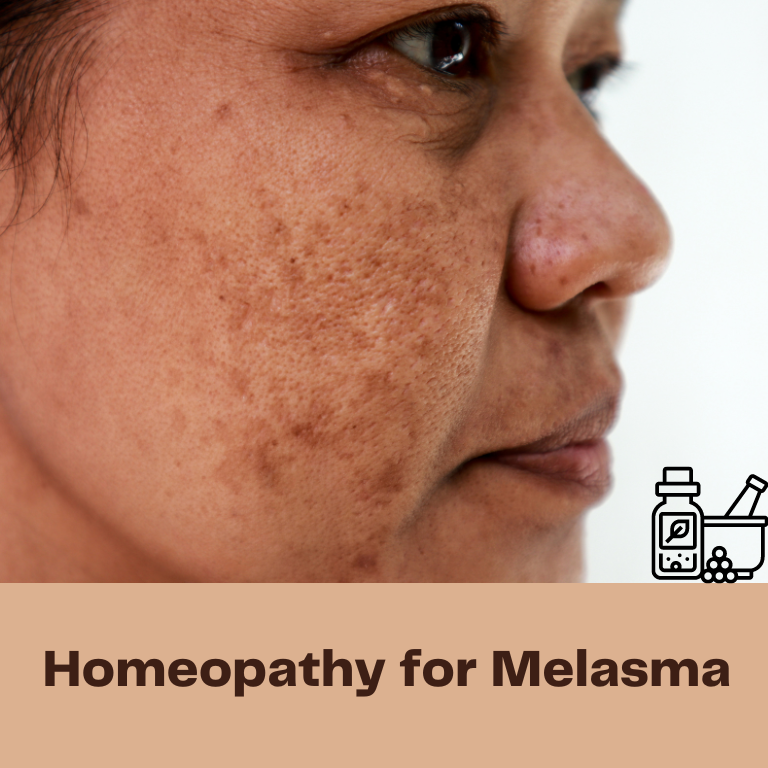What is Melasma?
Melasma is a common skin condition that is characterized by dark, irregularly shaped patches on the face. The patches typically appear on the cheeks, forehead, nose, and upper lip and can also affect the neck and arms in some cases.
Melasma is more common in women than men and is most often seen in individuals with darker skin tones. It is often triggered by hormonal changes, such as during pregnancy or while taking hormonal medications like birth control pills. Sun exposure is also a known factor in the development of Melasma.
While Melasma is not a dangerous condition, however, it can be distressing for those who experience it, as it can have a significant impact on a person’s self-esteem and quality of life.
What Causes Melasma
The exact causes of Melasma are not fully understood, but there are several factors that are thought to play a role in its development.
These include:
- Sun exposure: Exposure to ultraviolet (UV) radiation from the sun is a significant contributing factor to the development of Melasma. UV radiation can trigger the production of melanin, the pigment that gives skin its color, leading to the formation of dark patches on the skin.
- Hormonal changes: Melasma is more common in women than men and is often associated with hormonal changes such as those that occur during pregnancy or while taking birth control pills. Hormonal fluctuations can trigger melanin production and contribute to Melasma’s development.
- Genetics: Genetic factors play a significant role in the development of Melasma. Studies have shown that individuals with a family history of Melasma are more likely to develop the condition themselves. This suggests that a genetic predisposition to Melasma may be inherited from parents or other family members. Additionally, people with darker skin types, such as African, Asian, or Hispanic descent, are more prone to developing Melasma. This is because their skin produces more melanin, the pigment that gives skin its color, and genetic factors also influence melanin production. People with darker skin types are also more likely to experience post-inflammatory hyperpigmentation, which is the darkening of the skin that can occur after an injury or inflammation, such as acne or eczema.
- Certain medications: Certain medications, such as some antibiotics and anti-seizure medications, can increase the risk of developing Melasma in some people.
- Stress: Stress can cause Melasma; when a person experiences stress, their body releases a hormone called cortisol. This hormone can stimulate the production of melanin, which is the pigment that gives color to the skin. The overproduction of melanin in certain areas of the skin can lead to the development of hyperpigmentation, including Melasma.
While the exact causes of Melasma are not fully understood, avoiding excessive sun exposure and using sunscreen can help prevent its development or worsening.
Why is Melasma on the rise?
In recent years, the incidence of Melasma has increased, and several possible factors may be contributing to this trend.
- Increased sun exposure: With increased time spent outdoors, more people are being exposed to UV radiation from the sun, which can trigger melanin production and lead to Melasma’s development.
- Environmental factors: Exposure to environmental pollutants, such as air pollution, can cause oxidative stress and inflammation, which may trigger the development of Melasma.
- Changes in hormonal contraception: The use of hormonal contraception has become more widespread, and some forms of birth control may increase the risk of developing Melasma.
- Increased use of certain medications: Certain medications, such as antibiotics and anti-seizure medications, can increase the risk of developing Melasma in some people. With the increasing use of these medications, there may be an associated increase in the incidence of Melasma.
- Lifestyle changes: Modern lifestyle factors, such as increased stress levels, poor sleep habits, and a diet high in sugar and processed foods, may also contribute to the rise in melasma cases.
- Increased awareness and diagnosis: More cases may be diagnosed and reported with improved diagnostic tools and greater awareness of Melasma.
While it is unclear whether the incidence of Melasma is actually increasing, it is crucial to take steps to prevent its development or worsening. This includes limiting sun exposure, using sunscreen, and consulting a healthcare provider if you are concerned about skin discoloration or have been diagnosed with Melasma.
Conventional treatment of Melasma:
There is no known cure for Melasma, but several treatment options can help improve the skin’s appearance and reduce the visibility of dark patches.
Some of these options include:
- Topical medications: Certain topical medications, such as hydroquinone, tretinoin, and corticosteroids, can effectively reduce the appearance of Melasma. These medications work by inhibiting melanin production, which can help lighten dark patches.
- Chemical peels: Chemical peels use a chemical solution to exfoliate the skin and remove the top layer of damaged skin cells. This can help reduce the appearance of dark patches and promote the growth of new, healthy skin growth.
- Laser therapy: Laser therapy uses intense pulsed light (IPL) or other types of lasers to target and break down pigmented cells in the skin. This can help reduce the appearance of Melasma and promote the growth of new, healthy skin growth.
- Sun protection: Sun protection is essential to managing Melasma, as exposure to UV radiation can worsen the condition. This includes using broad-spectrum sunscreen with an SPF of 30 or higher, wearing protective clothing, and avoiding sun exposure during peak hours.
The above-mentioned conventional treatment options are available for managing Melasma, but some may have many potential side effects.
Here are some examples:
- Topical medications: Topical medications, such as hydroquinone, tretinoin, and corticosteroids, are commonly used to treat Melasma. However, they may cause skin irritation, redness, and peeling, primarily if used in high concentrations or for prolonged periods.
- Chemical peels: Chemical peels involve applying a chemical solution to the skin to exfoliate the top layers and reduce the appearance of Melasma. While they are generally safe, they can cause skin irritation, redness, and peeling, as well as potential scarring and hyperpigmentation if not performed correctly.
- Laser therapy: Laser therapy is a popular treatment option for Melasma that uses laser energy to target and break up melanin in the skin. However, it can cause skin irritation, redness, and swelling and may also lead to hyperpigmentation or hypopigmentation in some cases.
- Oral medications: Oral medications, such as tranexamic acid and oral contraceptives, may also be used to treat Melasma. However, they can have potential side effects, such as gastrointestinal issues, headaches, and blood clots.
It is essential to discuss the potential side effects of any treatment option with a healthcare professional before undergoing treatment for Melasma. They can help weigh the benefits and risks and determine the best course of action based on the individual’s unique needs and medical history.
Natural treatments of Melasma:
Some natural remedies help improve the skin’s appearance and reduce the visibility of dark patches in Melasma.
It’s always a good idea to consult a healthcare provider before trying any new treatment.
Some natural remedies for Melasma include:
- Aloe vera: Aloe vera is a natural moisturizer and has been shown to have anti-inflammatory properties.
- Licorice extract: Licorice extract has been shown to have skin-lightening properties and may help reduce Melasma’s appearance.
- Vitamin C: Vitamin C is a powerful antioxidant that can help protect the skin from damage and promote the growth of new, healthy skin growth.
- Green tea: Green tea contains polyphenols that have been shown to have skin-protective properties.
It’s important to remember that natural remedies may only be effective for some and may take longer to produce results than medical treatments. It’s always a good idea to consult a healthcare provider or dermatologist to determine the best course of treatment for you.
Homeopathy

Homeopathy is a natural & holistic medicine branch that uses highly diluted & potentized substances to stimulate the body’s natural healing processes hence bringing cure to the diseased.
Homeopathy is really helpful in addressing chronic skin issues such as Melasma, Eczema, Psoriasis, Acne, and Rosacea. Homeopathic remedies are selected based on the individual’s unique symptoms and overall health, and may be prescribed in conjunction with lifestyle and dietary changes to support overall skin health.
Some homeopathic remedies that may be recommended for hyperpigmentation include Sepia, Thuja, Sulfur, Ignatia.
Homeopathic remedies are highly individualized, and the appropriate remedy will depend on the individual’s unique symptoms and overall health.
As such, it’s important to work with a qualified homeopathic practitioner who can help select the most appropriate remedies and monitor progress over time.
Yoga for Melasma:
Yoga can be a helpful complementary therapy for managing stress, which is a known contributing factor to the development of Melasma.
Stress reduction techniques, such as yoga, may help to manage stress levels and potentially reduce the severity of Melasma.
If you found this blog helpful and informative, Like, Share & Subscribe!
In addition, if you’re dealing with skin conditions like Melasma, it’s important to use non-toxic and natural products.
That’s why Naturo Essentials body and hair wash was developed – it’s formulated to be gentle on the skin while providing nourishment and cleansing without any harmful chemicals, fragrances, or colors. It’s available for purchase on Amazon Australia.
Finally, if you’re struggling with Melasma, keep hope – a holistic approach to treatment can make a big difference.
Book your consultation now to help heal your skin issue holistically, naturally & from the root cause!

